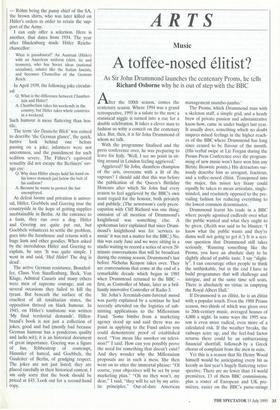Not funny but interesting
Julian Critchley
UNDERGROUND HUMOUR IN NAZI GERMANY, 1933-45 by Franz Hillenbrand Routledge, £45, pp. 297 Three years ago I gave lunch in the Commons to my daughter Melissa and an elderly German doctor with whom she had made friends while living in Germany. Dr Hillenbrand, who had, on one occasion, met Hitler ('surprisingly small; cold, hyp- notic eyes'), told us he was writing about underground humour in Nazi Germany, the covert gestures of hostility towards the regime; overt gestures took one swiftly to Dachau.
The book has now been published, and is dedicated 'To the memory of those who did not bow the knee to Baal'. Hillenbrand, who was too old to fight, practised medicine in Eastern Germany throughout the war. He has written a fascinating account of black humour; in origin, part Jewish, the rest mainly Viennese cabaret or from Berlin, a social democratic city of iconoclasts who, like cockneys, use rhyming slang as a cloak with which to disguise their opinions.
The book is divided into sections that relate to all the top Nazis from the Fiihrer downwards. Having placed the rise of Hitler in its political context, Hillenbrand has gathered up 1,000 or more examples of gallows humour (galgenhumor), illustrated with cartoons from the period. For exam- ple: the ideal German should be
As blond as Hitler, As tall as Goebbels As slim as Goering, And as chaste as Rohm.
— Rehm being the pansy chief of the SA, the brown shirts, who was later killed on Hitler's orders in order to retain the sup- port of the Army.
I can only offer a selection. Here is another, that dates from 1934. The year after Hindenburg made Hitler Reichs- chancellor:
What is paradoxical? An Austrian (Hitler) with an American uniform (shirt, tie and trousers), who has Soviet ideas (national socialism), salutes like the Italian fascists, and becomes Chancellor of the German Reich.
In April 1939, the following joke circulat- ed:
Q. What is the difference between Chamber- ' lain and Hitler?
A. Chamberlain takes his weekends in the country, but Hitler takes whole countries in a weekend.
Such humour is more flattering than hos- tile.
The term 'der Deutsche Buick' was coined to describe 'the German glance', the quick, furtive look behind one before passing on a joke; informers were not uncommon, and the punishment for such sedition severe. The Fiihrer's equivocal sexuality did not escape the Berliners' sav- age eye:
Q. Why does Hitler always hold his hand on his lower stomach just below the belt of his uniform?
A. Because he wants to protect the last unemployed.
As defeat looms and privation is univer- sal, Hitler, Goebbels and Goering tour the countryside in the hope of getting supplies unobtainable in Berlin. At the entrance to a farm, they run over a dog. Hitler and Goering are quite put out, but Goebbels volunteers to settle the problem, goes into the farmhouse and returns with a huge ham and other goodies. When asked by the incredulous Hitler and Goering to explain, he says 'It was quite simple. I went in and said, 'Heil Hitler! The dog is dead'.
The active German resistance, Bonnhof- fer, Claus Von Stauffenburg, Beck, Von Kluge, Admiral Canaris and many others were men of supreme courage; and on several occasions they failed to kill the tyrant. But beneath the surface of the cruellest of all totalitarian states, the opposition thrived on black humour. In 1945, on Hitler's tombstone was written 'My final territorial demands'. Hillen- brand's book is not just a collection of jokes, good and bad (mostly bad because German humour has a ponderous quality and lacks wit); it is an historical document of great importance. Goering was a figure of fun, Ribbentrop of contempt, Himmler of hatred, and Goebbels, the Ganleiter of Berlin, of grudging respect.
The jokes are not just listed; they are placed carefully in their historical context. I am only sorry that the book should be priced at £45. Look out for a second-hand copy.



















































 Previous page
Previous page